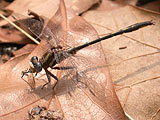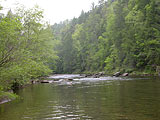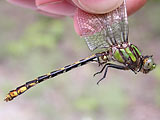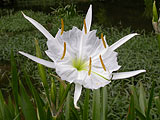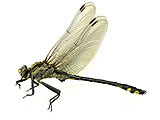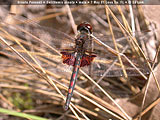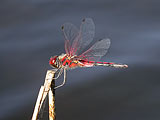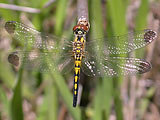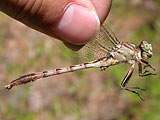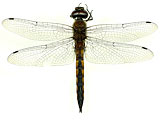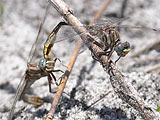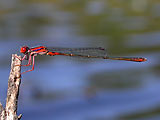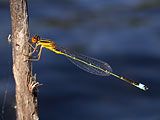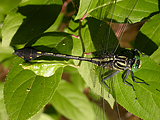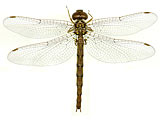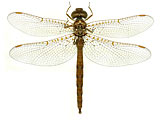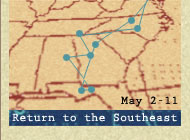
A second Southeastern Run, May 2 - 11.
After a couple of weeks of trying to clean up after the flooding of my basement and studio, I felt a little ill-prepared for the next long road trip for another set of Southeastern species. Weather is always a major factor in any dragonfly collecting trip and this one was no different as I zigged and zagged trying to get behind storm fronts and into the sun.
First stop: North Carolina
I had arranged to meet Giff Beaton in Northwestern Georgia on May 4 so I had to cover a lot of ground in the first two days. I aimed to get to the Sandhill Gamelands in Southcentral North Carolina by the end of the first day, Wednesday. The next day's weather was predicted to be cool and rainy so I was anxious to look for dragonflies even though I arrived at the late hour of 6:PM but the sun was still strong and hot. Off of US 1 I found a lake that Randy Emmitt wrote may have Diminutive Clubtail, Gomphus diminutus. Along the banks were Elfin Skimmers, Nannothemis bella, North America's smallest dragonfly. However nothing else was found except Common Baskettails, Epitheca cynosura, swarming in the failing sunlight.
The next morning I tried a nearby location that Randy said was the better spot for the clubtail. The morning started a little hazy but to my delight the sun shown brightly all morning. Near a second lake along the road I spotted a male Diminutive Clubtail but it flew away as I approached. I searched around the lake itself but saw no others. However at the outflow of a swampy area I found two males on the bank of a vegetated pond backwater. Following along the the edge of the swampy area I saw several more including females.
Species found at Sandland Gamelands:
Diminutive Clubtail/ Gomphus diminutus
Piedmont Clubtail/ Gomphus parvidens
Lancet Clubtail/ Gomphus exilis
Blue Corporal/ Ladona deplanata
Elfin Skimmer/ Nannothemis bella
Variable Dancer/ Argia fumipennis
Seepage Dancer/ Argia bipunctulata
Burgundy Bluet/ Enallagma dubium
Many thanks to Randy Emmitt and Jeff Pippen for information on this location.
Conasauga River, May 4.
Despite further threats of bad weather, I met with Giff Beaton on Friday to look the rare Edmund's Snaketail, Ophiogomphus edmundo, along the Conasauga River in southern Tennessee. Again the weather idiots were wrong and we had a perfectly sunny day. Males were found perching on rocks along certain stretches of the river and were quite difficult to approach. Females were not to be seen suggesting that they either spend their day in treetops, or under ground, or are otherwise invisible to the human eye. Uhler's Sunddragons, Helocordulia uhleri were common.
Many thanks to Giff Beaton for knowing the exact riffles favored by Edmund's Snaketails.
Dodging weather, a detour to Alabama, May 5.
With rain finally catching up to me in Georgia, I tried to get on the other side of the storm by heading west into Alabama. My target was Septima's Clubtail, Gomphus septima, a fairly large, dully marked species that I had originally planned to look for on my return trip through North Carolina. Giff and Steve Krotzer had seen them on the Cahaba River just a few days before. I stopped to admire the Shoal Lilies that bloom in the Cahaba River NWR, wading out in the warm sun to photograph them. Cobra Clubtails, Gomphus vastus, were emerging from the river. Later I did find my Septima's Clubtails (males are very wary) then headed back east in the afternoon now that I was behind the storm. I tried for Cinnamon Shadowdragon, Neurocordulia virginiensis, at sunset back in Georgia but I was at the wrong spot.
Tallahassee and vicinity, May 6 - 9.
I could have tried another day in Georgia but the weather didn't look great in any direction, so I decided to head south and get to Tallahassee, FL a day or two earlier than planned. At some of the sand bottomed ponds that I visited in March there would be a new set of species. Being Sunday there were a lot of swimmers and picnickers when I arrived at Lost Lake in the mid-afternoon. But dragonflies were plentiful. Where I only saw larval tracks along the water's edge in March, there were now a half dozen adult male Belle's Sanddragons, Progomphus bellei, along the sandy shore. Gray-green Clubtails, Arigomphus pallidus, also shared the beaches but they tended to disappear earlier in the afternoon than the Sanddragons. Perching on the emergent vegetation, were male Red-veined Pennants, Celithemis bertha. Late in the afternoon, Sepia Baskettails, Epitheca sepia, finally arrived to patrol the pond edge. They do look paler than other baskettails but the color of the setting sun plays a factor in their golden appearance.
Also present was a new damselfly species for me, Golden Bluet, Enallagma sulcatum. They are a bit more orange in the thorax than the more familiar and widespread Vesper Bluet, Enallagma vesperum. They have a strong black shoulder stripe unlike the Vesper.
I spent Monday, May 7 looking for females of the above species. I was pleased to find several females of the spot winged form of the Red-veined Pennant called leonora. However the females of the other species eluded me and a cool wind would reduced the evening Sepia Baskettail flight to a lone male.
The next morning I met with Jerrell Daigle and Alex Ardila-Garcia, a M.Sc. candidate from the University of Guelph in Ontario who intended to collect dragonflies for his DNA study. We tried some different habitat, a sandy stream some 40 miles west of Tallahassee. We spent most of the day on Sweetwater Creek in Liberty Co. Sweetwater Creek is an absolutely beautiful spot, easy to wade and teeming with a few characteristic species, the most common being the Common Sanddragon, Progomphus obscurus. Along the road Jerrell found a female Blackwater Clubtail, Gomphus dilatatus, a very large species with an impressive club at the end of the abdomen. I spotted a male with his even bigger club but it flew off before I could get down the steep bank to try to net it. Also along the road, Alex netted a female Twin-striped Clubtail, Gomphus geminatus, another one of my targets.
It took a little while for activity to warm up on the stream itself but soon in almost every sunny patch perched a male Blackwater Clubtail. I couldn't alway see them before I flushed them but by waiting patiently I could net them as they came back. Finding Twin-striped Clubtails was a bit tougher but I eventually saw a couple of males. Late in the afternoon, one landed on the bridge itself but in a difficult position to get the net squarely on. I was hoping by slapping the net up against him he would fly up into the net but when I swung he didn't even move. I ended up catching him with my fingers.
That evening we were at the Apalachicola River at Bristol waiting for a flight of Neurocordulias, Shadowdragons. We stopped here to look around during the day and Jerrell was excited to try the spot for Smoky Shadowdragon, Neurocordulia molesta, a species that hasn't been seen here in many years. He found two exuviae along the banks. Despite the low water levels, it was a difficult bank to catch dragonflies. You could wade a short distance but the bottom quickly drops off to deep water. I settled on a rock that jutted out over the water a bit but Jerrell and Alex elected to wade. It was late, around sunset when the Shadowdragons started flying. I could see them coursing by me about 6 feet out of reach. Jerrell managed to catch one early on but no one else was having any luck as the dragonflies were flying fast and not close to shore. I abandoned my rock to wade and had a couple of better swings but failed to catch any. Both Jerrell and Alex stepped into holes and got wet. All in all a pretty frustrating experience.
The female Jerrell caught turned out to be Cinnamon Shadowdragon, Neurocordulia virginiensis, which I needed so the evening was not a total loss.
May 9 was my last day in Tallahassee and turned out to be by last productive day of the trip. We went looking for those females I needed and eventually got Sepia Baskettail and Gray-green Clubtail but no Belle's Sanddragon. That night I went back alone to Sweetwater Creek to wait for another Shadowdragon species, Neurocordulia alabamensis. I waited in the stream, got excited then disappointed by a flight of Baskettails. In the dying light I practiced netting them and the occasional Swamp Darner, Epiaeschna heros. It was good practice because at 8:15 I saw something coming at me that appeared a bit paler than the baskettails. I took a swing and caught it and it was indeed a Alabama Shadowdragon male. I thought something like, "Okay, NOW they'll be coming out." I waited. Large pale yellow mayflies started dancing all around me on the stream, a lovely sight while I waited. I waited until 9:PM when it was too dark and probably too cool for any more dragonflight before leaving the water and driving back to the motel.
Many thanks to Jerrell Daigle!
Little on the way home.
Giff gave me a location for Appalachian Snaketail, Ophiogomphus incurvatus, in Georgia and Jerrell gave me one in North Carolina. I got to Giff's on midday Thursday, but large cumulus clouds kept the temperature down and I saw little but a few Ashy Clubtails, Gomphus lividus. The next day I was at Country Line Creek in NC but found neither Skillet Clubtails, Gomphus ventricosus, along the power line cut or Appalachian Snaketails along the creek. There was a Springtime Darner, Basiaeschna janata, a Harlequin Darner, Gomphaeschna furcillata, and a Stream Cruiser, Didymops transversa. Just emerging were Ebony Jewelwings, Calopteryx maculata, and Eastern Least Clubtails, Stylogomphus albistylus. I considered staying but felt tired. I never sleep well on these trips and the late nights chasing after shadowdragons and staying up to scan specimens had taken a toll. I was eight hours from home and decided to sleep in my own bed that night. I made it by 11:15PM, logging a total of 3150 miles in the gray Prius.

